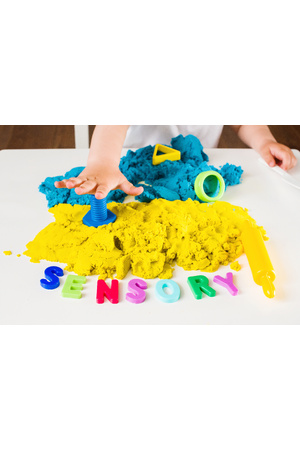Fun and easy sensory activities for you and your children

No matter if you’re 2, 22 or 52, it’s easy to find delight in activities that engage your senses – but did you know that feeling the graininess of mud as you squelch it between your toes or exploring the different sounds glasses make as they’re filled up with varying amounts of water are sensory activities that children can learn from?
Sensory activities are, by definition, any activity that stimulates a child’s senses, but they often revolve around touch, sight, and hearing. Sensory play is great for helping children improve their focus, develop motor skills, and build an understanding of the world around them. Play-based learning can also help children with sensory processing disorders.
As a bonus, play-based learning can be a wonderful way to bond with your child.
Creating your own sensory activities doesn’t have to be hard or expensive. Here are some simple age-appropriate sensory play ideas that you can share with your kids, using items you may already have in your home.
Babies (under 2 years)
At this age, children should be very well supervised, and all activities should be taste-safe and free from choking hazards.
- Scrunch coloured paper. Listen to the noise it makes, feel its textures, and see the shape change.
- Fill a tray with water and sponges. Pick up and squeeze the sponges and splash in the water.
- Use coloured yoghurt to “paint”. Choose different colours and experience how the yoghurt feels in your hands.
- Pop a Pop It Fidget toy together..
Toddlers (age 2 – 4 years)
Children at this age are starting to want to do things for themselves – they may need a little direction at first though, so don’t be shy about joining in!
- Create your child’s first piece of art with some fun finger paints. Make sure to point out the different colours and how the paint feels on your fingers when it’s wet and when it’s dry.
- Fill a tray with ground up rice bubbles or Milo. Practise drawing shapes and letters with your finger or a pencil.
- Pour rice or pasta into a bin. Let your child shovel the rice/pasta into containers with a scoop or their hands. Use containers of different sizes to show how heavier objects are harder to move.
- Set up a station with plastic cups and bowls. Fill some of these with water (you can add food colouring) and leave others empty. Pour the water into different cups and bowls.
Young Children (4 years and above)
By this age, it’s likely that children will need less direction from you on how to undertake the activity – but they’ll probably want your permission, and they’ll still need to be supervised.
- Tape bubble wrap to a table and squirt dollops of shaving cream and paint on it. Feel the different textures, pop bubbles and mix the colours together.
- Freeze berries and water in a container. Then use different toy tools to excavate the fruits from the ice.
- Make Oobleck by mixing water and corn starch (you can also add food colouring). Oobleck acts like a liquid when it is being poured but becomes more solid when a force is acting on it, so there are lots of ways for children to play and explore.
- Build sandcastles with Sensory Magic Sand and knock them down again!
Sensory products at Teacher Superstore
Looking for more sensory products? Here are a few of our favourites available online.
Browse our range of sensory resources at Teacher Superstore:
https://www.teachersuperstore.com.au/subject/development-differentiation/sensory-resources/
Leave a comment
Recent Blog Posts
- Boosting Your Child's Reading Skills: Easy Intervention Strategies
- Cultivate Growth Mindset: Nurturing the Power of Effort and Perseverance
- Gamify Learning: Ignite Engagement and Motivation with Interactive Games
- Top 10 Tips for Exploring Science at Home
- Enhance Your Child's Maths Skills with Teacher Superstore's Maths Resources: A Guide for Parents
- Integrate Technology: Transforming Classrooms with Digital Tools
- Homework Help 101: Effective Tips for Parents
- Use Formative Assessments: Guiding the Student Learning Journey Through Timely Feedback
- Creating a Positive Learning Environment at Home: Tips for Parents
- Embrace Project-Based Learning: Unleashing Student Potential in a Real-World Context
View All Posts
General
Help Topics
- Browsing and Buying
- Member Benefits
- Shipping and Delivery
- International Shipping
- Payment and Billing
- Returns Policy
Legal
View All Posts

